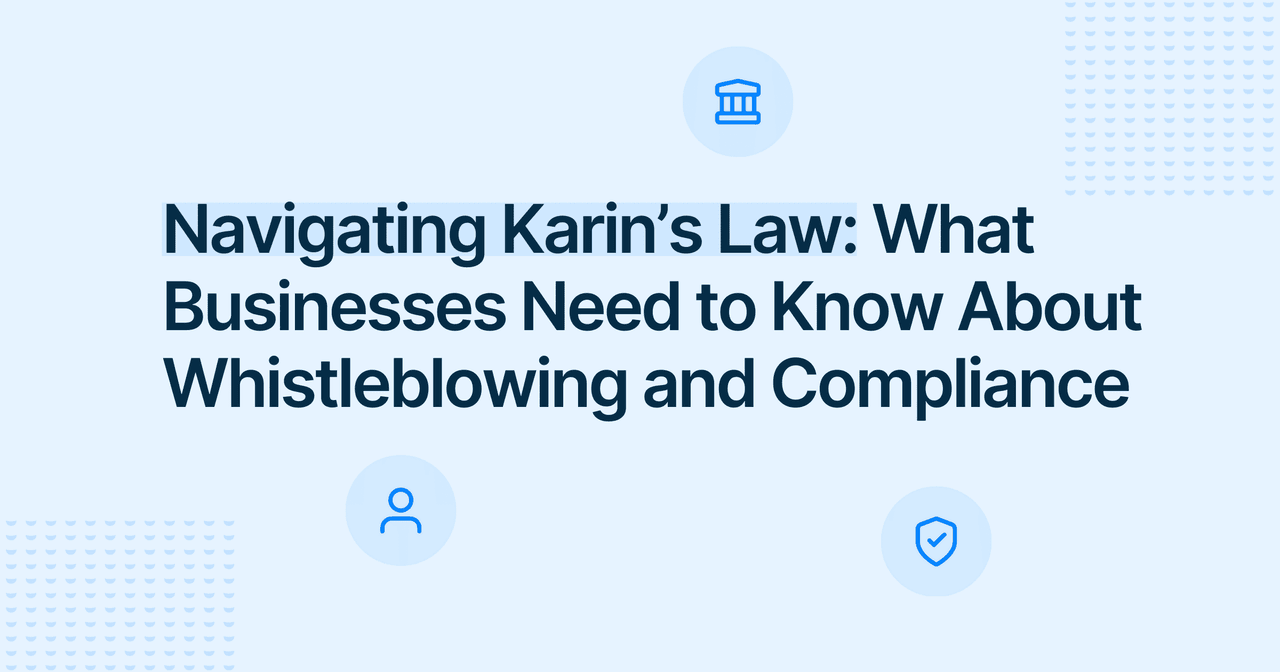




Whistleblowing

Alaa El-Shaarawi
Copywriter and Content Manager
Published
2025-11-03
Reading time
8 min


Table of contents
Subscribe to our newsletter
You see it happen: A report that disappears before it reaches leadership. A safety rule quietly skipped. A conflict of interest brushed aside.
Speaking up sounds simple, but for most people, it’s not. They weigh the risks: Will this backfire? Will anyone listen? Fear of reprisal and unclear whistleblowing policies often keep important issues hidden, sometimes until it’s too late.
Australia’s Corporations Act 2001, guided by ASIC, outlines clear whistleblower protections. The challenge is putting them into practice. Policies might look strong on paper, but it’s trust, communication, and consistent follow-up that determine whether employees actually feel safe to speak up.
A healthy whistleblowing system does three things: problems are discovered early, integrity is upheld, and employees know their voice matters.
That’s where FaceUp comes in, making it simple for employees to speak up safely and for compliance teams to act quickly, transparently, and confidently. From policy on paper to trust in practice: here’s how Australian organisations can get whistleblowing right.
Every organisation faces challenges, from honest mistakes to ethical gray zones. The difference between fixing issues early and letting them spiral often comes down to one person choosing to speak up.
When people stay silent, small problems become scandals. A single disclosure can prevent years of damage, reputational loss, and financial fallout. It’s not the size of the issue that matters, but whether someone feels safe enough to report it.
A strong whistleblowing system catches problems before they grow. But it works only when employees trust the process: clear reporting channels, timely investigations, and transparent follow-up. Without that trust, even the best-written policies sit unused.
Every report should be logged, tracked, and handled by someone accountable, in line with the Corporations Act 2001, Fair Work guidance, and Respect@Work positive duty requirements.
True accountability, however, goes further: it’s about creating a culture where speaking up is safe, respected, and acted upon.
For a full breakdown of protections and obligations, see our Whistleblowing Legislation in Australia Guide.

Whistleblowing works, and it’s already made a difference in Australia. Employees speaking up have exposed misconduct, prevented harm, and sparked lasting change.
Here are some real-world examples that show how effective whistleblowing protects employees while enabling proactive organisational action:
These examples highlight a pattern: when organisations listen, they don’t just avoid penalties. They evolve. Whistleblowers, once seen as troublemakers, are now increasingly recognised as essential contributors to ethical growth and risk resilience.
Whistleblowing frameworks work best when built on trust, not just compliance. Organisations can meet legal standards and create a confident reporting environment by focusing on these core components:
| Component | What It Means | Purpose / Outcome |
|---|---|---|
| Clarifying Protections | Identify and communicate who’s protected under the Corporations Act | Ensures employees, officers, contractors, and relatives know their rights |
| Secure Reporting Channels | Internal systems, regulators, anonymous options | Encourages safe disclosure and protects anonymity |
| Centralising & Tracking Reports | Assign ownership, set deadlines, maintain records | Keeps cases compliant with Fair Work guidance & WHS psychosocial codes |
| Following Up Whistleblowers | Keep employees informed of progress | Builds trust and ensures transparency |
| Training Staff | Educate all employees and leadership on obligations and reporting | Prevents mishandling, promotes awareness of protected disclosures |
| Regular Review & Testing | Assess process accessibility, fairness, clarity | Keeps framework effective and up to date |
Whistleblower protections under the Corporations Act 2001 shield employees, officers, contractors, suppliers, and their relatives from dismissal, demotion, or harassment. Reports can be made internally, to regulators like ASIC or APRA, or, in some cases, publicly if there’s a clear public-interest reason.
To qualify for legal protection, disclosures should:
Confusion is common. Many employees don’t know who qualifies or where to report misconduct. This uncertainty often discourages reporting altogether. And without clear internal systems, even well-intentioned reports can be mishandled.
That’s why tools like FaceUp exist: to simplify reporting, protect anonymity, and help organisations handle each case correctly and in line with Australian law.
Whistleblowing requirements apply across all sectors, but the practical challenges vary. Each industry faces its own mix of regulations, sensitivities, and operational realities.
According to ASIC’s 2023 RG 271 Implementation Review, many organisations still rely on spreadsheets or manual tracking, leading to missed deadlines and inconsistent case handling.
This creates compliance risks and undermines employee trust in the system. Integrated tools like FaceUp centralise reports, automate workflows, and maintain compliance while protecting anonymity.
Regulatory Guide 271 sets expectations for complaint handling and internal reporting systems. Investigations must be timely, impartial, and well-documented, with transparent communication.
Consistency, visibility, and traceability are key to meeting regulatory expectations and proving organisational integrity during audits. Manual systems make that hard to achieve.
Automated platforms like FaceUp provide structured workflows, case management dashboards, and reminders to keep everything on track and audit-ready. When HR and compliance teams share a platform, reports are handled faster, whistleblowers feel supported, and organisations stay ahead of regulatory expectations.
Whistleblowing in Australia has grown beyond a static compliance requirement. Evolving whistleblowing laws, global standards, and new technology are redefining how organisations manage and protect disclosures.
Key trends:
Research shows that when organisations stand behind their whistleblowers, trust follows. It’s one of the clearest signs of a strong and ethical workplace culture. Leaders who act on disclosures, not just acknowledge them, set the tone for accountability across every level of the business.
How to stay current:
Corporate governance is strengthened when organisations take whistleblowing seriously. It helps uncover conflicts of interest, financial irregularities, and operational gaps that might otherwise go unnoticed.
For Australian companies with international operations, alignment with standards like the EU Whistleblowing Directive is increasingly important. Consistent, transparent processes across borders strengthen accountability and show integrity to stakeholders.
Steps for governance integration:
Visible follow-through sends a positive message: speaking up is respected. It also signals to investors and regulators that ethical conduct is embedded, not enforced.
Each whistleblower report offers a piece of insight. When multiple disclosures are reviewed together, they create a fuller picture of an organisation’s health, revealing systemic risks, cultural weaknesses, and recurring operational issues.
By treating whistleblowing as a source of strategic intelligence, organisations can move from reactive investigation to proactive governance. Early awareness of these trends allows leaders to address root causes before they escalate.
Beyond identifying isolated incidents, aggregated reports highlight broader trends and patterns. This offers the kind of actionable intelligence that strengthens culture, accountability, and long-term performance.
Over time, this transparency becomes a competitive advantage; trusted companies attract talent, customers, and investors, building loyalty across all fronts.

Policies alone don’t create a speak-up culture. Employees need reassurance that reporting misconduct won’t have negative consequences, and that their input is respected. Culture is built in the moments between rules and reactions; how leaders respond when someone takes the risk to speak up.
Key components include:
Secure hotlines and anonymous reporting options make employees more likely to speak up, building trust across the workplace.
When people see that reports lead to real change, policy updates, leadership action, or improved conditions, the fear barrier breaks. That’s when whistleblowing transforms from a compliance checkbox into a living part of organisational integrity.
Whistleblowing is one of the clearest measures of an organisation’s integrity and resilience. Clear, protected reporting channels embedded in a supportive culture provide early insight into emerging risks, improve governance processes, and build trust with employees, customers, and stakeholders
Platforms like FaceUp provide confidential reporting, secure follow-up, and actionable insights, allowing compliance teams to manage cases efficiently while maintaining employee trust.
Book a demo today to see how FaceUp can help your organisation transform whistleblowing into a cornerstone of trust and operational excellence.





Keep Reading

Marie Roland2025-12-165 min
Whistleblowing

Alaa El-Shaarawi2025-12-087 min
Workplace Environment

Alaa El-Shaarawi2025-12-058 min
Legal & Compliance

Alaa El-Shaarawi2025-12-048 min
Legal & Compliance